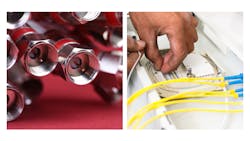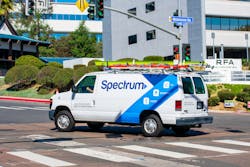The cable MSO community talks a lot about improving the capacity and efficiency of their HFC networks. On the table are evolving from the current DOCSIS® 3.1 generation to DOCSIS 4.0 as well as implementing Distributed Access Architectures (DAA). With such chatter in mind, it may be easy to forget that the “F” in “HFC” stands for fiber (as in “hybrid fiber/coax”). Fiber therefore has a major role to play as cable operators upgrade their infrastructures to support symmetrical 10-Gbps transmission capabilities.
The program at this October’s SCTE Cable-Tec Expo – the most important cable industry technical conference and exposition in the Americas and likely the world as well – will reflect the key role of fiber in the average cable MSO’s network, says Chris Bastian, senior vice president and CTO, engineering, at SCTE. Which would make SCTE Cable-Tec Expo a more worthwhile addition to a fiber professional’s travel schedule than one might think.
Keeping on track
“We've always been working very closely with CableLabs but [the merger] has just put it on steroids,” Bastian explains. “SCTE is getting involved a lot earlier than we have been, getting a heads up on the work that CableLabs is coordinating. So we have more papers this year from CableLabs. We have more moderators from CableLabs…It’s really been beneficial.”
After a COVID-induced all-virtual format last year, the 2021 Expo will provide both live and virtual experiences from the Georgia World Congress Center in Atlanta October 11-14. The Expo’s Fall Technical Forum and the preceding workshops will feature 53 technical sessions, with the Forum’s programming arranged into 10 tracks. Three tracks in particular should see fiber-related discussions, says Bastian:
- Wireline Access
- Converged Networks and Mobility
- Operational Transformation.
Much of the “Wireline Access” track reflects the realities of current and future network operations. Just as many telcos have tried to wring as much out of their existing DSL networks as possible before moving to fiber to the home (FTTH), cable MSOs (with the assistance of CableLabs) continue to push the capacity boundaries of their DOCSIS HFC networks. The 10G initiative and the DOCSIS 4.0 advances that will help enable it therefore grab most of the technology headlines. But, in greenfield applications, cable MSOs are more than happy to deploy all-fiber access networks, Bastian confirmed. Therefore, next-generation PON and how it can support the achievement of the 10G goal will be an important topic of discussion at Expo this year.
For example, Curtis Knittle, vice president, wired technologies at CableLabs, will moderate a session at 3:00 PM, October 12, aptly named “Fiber to the Home: The Other Path to 10G.” The session is expected to include presentations from Armstrong as well as Cox Communications on their experiences with FTTH.
Next-generation PON also has a potential role to play in converged networks, as exemplified in the presentation from Cox titled "On the Road to 10G: Converged Access Platform for Both HFC and Ultra Long NG-PON," that will be part of the “Converged Networks and Mobility” track. The presentation will be part of a session on October 12 at 1:00 PM that will address the question “Is Fiber the Key to Transport Convergence?” Other presentations will cover coherent point-to-multipoint networking (a new point of interest for CableLabs; see the sidebar) and how Shaw Communications has integrated Ethernet and OTN traffic over 100G and 200G wavelengths.
On Thursday for the same track, the session “Network Slicing and Multi-Access Edge Convergence: Coming Soon to an Access Network Near You!” also should appeal to the fiber focused, according to Bastian. The session will include a presentation on network slicing techniques from Ciena, while Nokia will present on fixed network and fixed wireless access integration.
Bastian sees fiber playing a growing role in converged cable MSO networks. “I think as COVID has been easing off, I'm hearing of more resumption of fiber-deep builds,” he says, referencing fiber extension efforts that can go hand-in-hand with DAA and DOCSIS 4.0 initiatives. “[When] you put that new node out there, that can serve the mobile convergence piece so that you have that edge, that converged edge.
“You don't just serve coax off of that fiber node. You can serve PON. You can go from fiber to fiber, have the Ethernet on one side and your PON interface on the other or you could serve LTE or you could serve WiFi,” he continued. “So you have that multi-access protocol on the one side of the fiber node by pushing that fiber closer in…Going fiber deeper has multiple purposes that it could serve, not just getting fiber closer to the customer to provide HFC.”
Convergence is one of many operational transformations now underway in cable operator networks. Bastien points out that many of the topics discussed within the “Operational Transformation” track will have implications for how such operators manage their fiber infrastructures. In this vein, October 14’s “Advances in Operational Tooling” session will feature a presentation from Comcast titled “It's 9:00 AM and Your Fiber Is Still Dark" (a follow-on from last year’s “It’s 10 PM: Do You Know Where Your Wavelengths Are?”) that will discuss fiber monitoring strategies.
Fiber on the Floor
And that role should continue to grow in prominence, according to Bastian, particularly as operator footprints increase. “Really the HFC segment is very short, you know, just home to node. And it's backstopped by thousands and thousands of miles of fiber in any robust cable network,” he explains. “And on each of those segments, the speeds are constantly increasing. So we're having the 1-gig standard out to the nodes now and then it was 10G around the regional. Now they're going up to 40G, 100G around the regional. As you go deeper and deeper into the network, you just have that ramping up, that tiering up of the speeds.”
Which means that fiber should remain a major part of the SCTE Cable-Tec Expo conference program for years to come.
STEPHEN HARDY is editorial director of Lightwave.
[Sidebar]
CableLabs Considers Coherent
Coherent has earned a key role in a variety of optical network applications, from long haul to data center interconnect and metro. CableLabs began looking at the technology’s potential application to cable operator’s access networks a few years ago. The result is a set of specifications that address 100G and 200G point-to-point applications as well as the kickoff of specification work for coherent-based 100G PON architectures.
As the bandwidth demands between headend and hub continue to increase (particularly as operators employ Distributed Access Architectures), some cable operators fear that older fiber might not be able handle the strain. CableLabs developed an initial set of specifications in 2018 that describe cost-optimized optical transceivers that will support 100-Gbps coherent transmission based on dual-polarization differential quadrature phase-shift keying (DP-DQPSK) over at least 40-km unamplified links. A novel aspect of the specifications is “Full Duplex Coherent Optics” that support bi-directional transmission over a single wavelength via the use of circulators. Following on, the “P2P Coherent Optics Physical Layer 1.0 Specification (P2PCO-SP-PHYv1.0-I03-200501)” specification that also covers 200-Gbps applications was published last year.
New this year is the “Coherent Termination Device Requirements Specification.” According to Curtis Knittle, vice president, wired technologies at CableLabs, the device, which could be cabinet- or node-based, would terminate the point-to-point coherent link and switch/route packets to/from network edge devices such as Remote PHY devices, Remote MACPHY devices, remote OLTs, and mobile sites, among others. The device would be constructed to enable low-cost, 10-Gbps or 25-Gbps grey optical links. Having highlighted a 100G technology demonstration at SCTE Cable-Tec Expo in 2019, CableLabs hopes to host a 200G coherent interop later this year.
Meanwhile, CableLabs announced earlier this year that it will begin development of 100G single-wavelength coherent PON (CPON) technology. Knittle, who also chaired the development of the IEEE 802.3ca 25G/50G PON specifications, says the effort will not only seek to increase PON capacity via coherent transmission but extend reach by 4X to 80 km and split ratio by 20X to 512 versus conventional PONs. CableLabs is targeting a 24-month specification process, according to Knittle.
About the Author

Stephen Hardy
Editorial Director and Associate Publisher, Lightwave
Stephen Hardy is editorial director and associate publisher of Lightwave and Broadband Technology Report, part of the Lighting & Technology Group at Endeavor Business Media. Stephen is responsible for establishing and executing editorial strategy across the both brands’ websites, email newsletters, events, and other information products. He has covered the fiber-optics space for more than 20 years, and communications and technology for more than 35 years. During his tenure, Lightwave has received awards from Folio: and the American Society of Business Press Editors (ASBPE) for editorial excellence. Prior to joining Lightwave in 1997, Stephen worked for Telecommunications magazine and the Journal of Electronic Defense.
Stephen has moderated panels at numerous events, including the Optica Executive Forum, ECOC, and SCTE Cable-Tec Expo. He also is program director for the Lightwave Innovation Reviews and the Diamond Technology Reviews.
He has written numerous articles in all aspects of optical communications and fiber-optic networks, including fiber to the home (FTTH), PON, optical components, DWDM, fiber cables, packet optical transport, optical transceivers, lasers, fiber optic testing, and more.
You can connect with Stephen on LinkedIn as well as Twitter.

